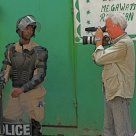The state investigator was named Oswaldo Delgadillo, and he had a thick file on his desk that we desperately wanted to see. Reporter Sean O’Shea, cameraman Elias Campbell and I were eyeing it greedily.

The day was hot. Humidity near 100%. Puerto Vallarta in September is purgatory. We could see the documents in the file curling with the heat. The documents detailed the police investigation into a missing persons case: the disappearance of a 22-year-old Canadian, Diego Hernandez, and his American friend, Craig Silva. They’d been missing since May 8, and both families felt that the police were dragging their feet. Diego’s mother believed the local cops may even have kidnapped them.
Read more: Missing in Mexico
“Can we at least film the outside of the file, to show that police are working hard?” we asked.
But Oswaldo was adamant. He was ready to talk to us in generalities about the police investigation. We could take notes. But no cameras. No interviews . And definitely no look into the file.
We tried to explain the needs of television. Oswaldo shook his head. Finally, I said: “Can you ask your boss?”
“Si, “ he said, and left the room . He left us alone with the Hernandez file sitting on his desk. In the movies, this kind of lapse is usually a subtle signal from a sympathetic cop: If you want to have a glance at the file while I’m gone, go ahead, I won’t know about it.
But this was no movie. This was real-life Mexico and Oswaldo was no friendly cop. We were on foreign soil. And he could come back anytime and throw us into a dungeon for tampering with a police investigation. Jails in Mexico are known to be hot and dark. We bit our lips and waited.
He came back with bad news. No interview. No filming.
It was a Thursday, we were flying out Saturday, and we were at wits’ end. It was time for Plan B. Time for some camera-rattling.
In my notes, I had the number for the Governor of the State of Jalisco. So I told our driver/fixer Arturo to call his office in Guadalajara. Tell the governor’s chief of staff we were a Canadian TV crew, doing an investigation into the case of a missing Canadian. And while he was at it, to call Attorney-General Luis Najera as well. Tell them both we were on deadline.
We didn’t have to mention the obvious: Canadians are vital to Mexico’s tourist trade. More than 1.5 million visitors every year. More than 50,000 ex-pat Canadians have homes in Mexico.
A flubbed police investigation into a missing Canadian could make those tourist dollars nervous.
So we lit the fuse, and we waited.
An hour later, the Attorney-General’s office called back. He would see us tomorrow—Friday—at 1pm in the Puerto Vallarta Marriott Hotel. His office would make all the arrangements. Could we send more information about who we were? I had with me a letter of introduction in Spanish. I photographed it with my smartphone, and emailed it to Guadalajara.
Plan B was launched.
The next day, an hour ahead of schedule, the entourage of Attorney-General Luis Najera arrived at the hotel. He was accompanied by army marksmen and personal bodyguards and a staff of six. (High-profile law enforcers in Mexico are often targeted by drug cartel hitmen.) The helicopter ride from the state capital had taken an hour.
Reporter Sean O’Shea shook his hand and remarked that in Canada, only the Prime Minster travels with such a large posse.
“Yeah, but you don’t have the same problems we have here,” Najera remarked sardonically. And he was here to solve a particular problem.
With that, he slipped off his sidearm, handed it to an aide, and sat down for the interview.
Don’t miss “Disappeared” this Saturday at 7pm on 16×9.


Comments